Understand The WPATH letter template, how to get one, and why they’re essential for gender-affirming surgery. Includes templates, FAQs, and resources for support.
Feeling like your body doesn’t match who you are inside can be incredibly difficult. This feeling is called gender dysphoria, and for many transgender and nonbinary individuals, gender-affirming surgery is a life-changing solution. But often, access to this surgery starts with a special letter called a WPATH letter. What exactly is it, and how do you get one? Read on to find out.
What is a WPATH Letter?
A WPATH letter is a formal document written by a qualified mental health professional (like a therapist, psychologist, or psychiatrist) who specializes in transgender healthcare.
Why Do You Need One?
This letter does two important things:
- Says what’s going on: It explains that you have gender dysphoria.
- Says what you need: It says that gender-affirming surgery is important for your health and happiness.
Think of it like getting a special permission slip for the surgery. Insurance companies often want to see this letter before they agree to help pay for it.
Who is Qualified to Write a WPATH Letter?
Not every doctor can write a WPATH letter. It needs to be someone who specializes in mental health and understands what it means to be transgender. Here are the usual types of professionals who can write these letters:
- Psychologists: They are experts in how our thoughts and emotions work. They can help you explore your gender identity and make sure you’re emotionally prepared for surgery.
- Psychiatrists: These medical doctors focus on mental health. They can diagnose gender dysphoria and help if you have other worries or mental health needs.
- Licensed Clinical Social Workers (LCSW): These professionals offer therapy and support. They often have special training in helping transgender people.
- Other Therapists: Some counselors, even if they aren’t exactly the ones listed above, might be able to write the letter. The important thing is that they’ve worked with a lot of transgender folks and know the WPATH rules well.
What key information is included in a WPATH letter?
WPATH letters need to include some specific information to help you get the gender-affirming surgery you need. Here’s a breakdown of what’s usually inside:
1. Patient Identification
- Legal Name: The name on your driver’s license or other official documents.
- Preferred Name and Pronouns: How you want to be called and the pronouns that fit you best (like she/her, he/him, or they/them).
- Gender Identity: How you describe yourself (like transgender woman, transgender man, nonbinary, etc.).
2. Diagnosis
- Gender Dysphoria: Your therapist will clearly say that you meet the official criteria for gender dysphoria. This is usually based on a big rulebook for mental health professionals called the DSM-5.
3. Treatment History
- Therapy Time: How long you’ve been working with your therapist and talking about your gender.
- What You’ve Focused On: The goals you and your therapist had, and what you worked on in your sessions.
- Other Treatments: If you’ve done anything else to help with your gender dysphoria, like hormone therapy or changing how you dress and present yourself.
- How You’re Doing: Your therapist will assess your mental and emotional health, to show you’re ready for surgery.
4. Surgical Readiness Assessment
- Understanding: Your therapist confirms you get the good, the bad, and the limits of the surgery you want.
- Decision-Making: Your therapist says you’re mentally able to make this big decision for yourself.
- Realistic Outlook: Your therapist checks that you understand what the surgery can and can’t change.
5. Recommendation and Rationale
- Clear Support: Your therapist will straight-up say they recommend the gender-affirming surgery you want.
- Why It’s Needed: They’ll write a strong statement about why this surgery is medically necessary for your health and happiness. This part is super important for insurance!
Additional Notes:
- Length: WPATH letters can be a few pages long.
- Special Requests: Some surgeons or insurance companies might want extra details in the letter.
- Just For You: Every letter is a bit different, even with the same basic info! It should be all about YOUR story and why YOU need the surgery.
Are There Different WPATH Letter Templates for Different Surgeries?
While there might not be a totally separate template for every single kind of gender-affirming surgery, your WPATH letter might change a bit depending on what procedure you’re getting. Here’s why:
Zeroing In: The letter will really focus on how the surgery helps with your specific gender dysphoria and makes you feel better overall. For example:
- Top Surgery (Chest Reconstruction): The letter might talk a lot about how chest dysphoria affects your everyday life, how you dress, and even your mental health.
- Bottom Surgery (Genital Surgery): The focus could be on the distress your current body causes you, problems it creates, or the positive changes the surgery would bring to your life.
Surgeon’s Requests: Some surgeons want extra details or a slightly different format for their WPATH letters. It’s a good idea for your therapist to call the surgeon’s office and double-check if there’s anything special they need.
How Many Letters? The WPATH Standards of Care usually say you need:
- One letter for top surgery
- Two letters from different therapists for bottom surgery. This helps make extra sure the decision is right for you.
WPATH Letter Template
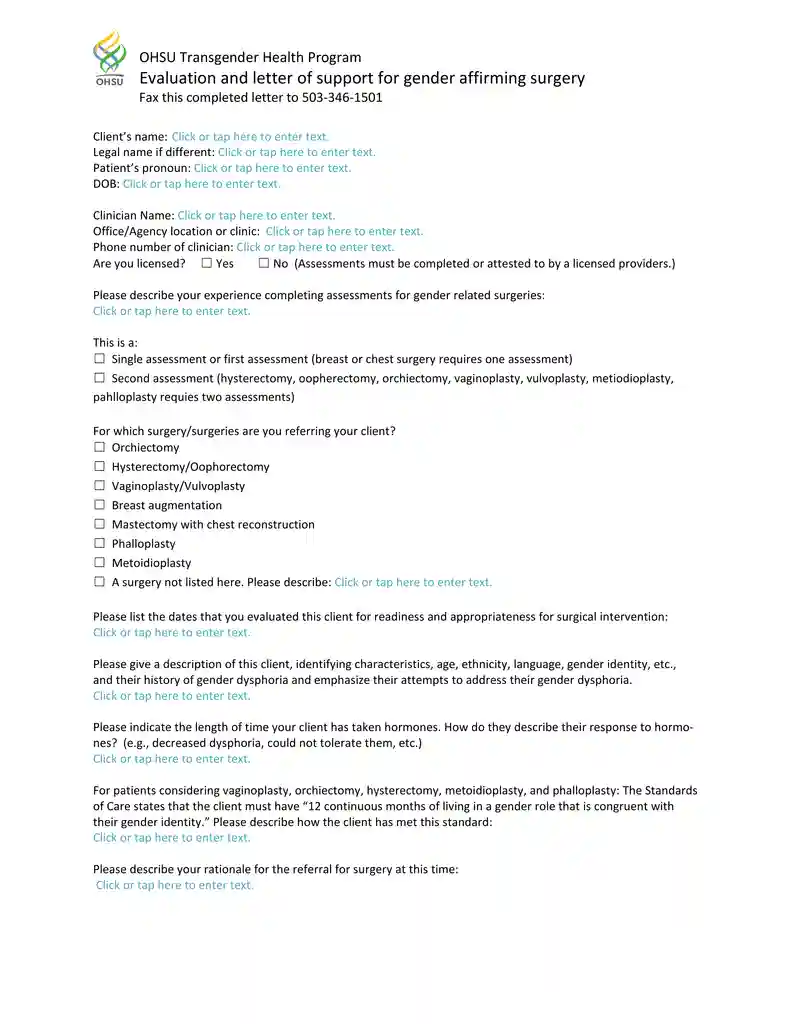
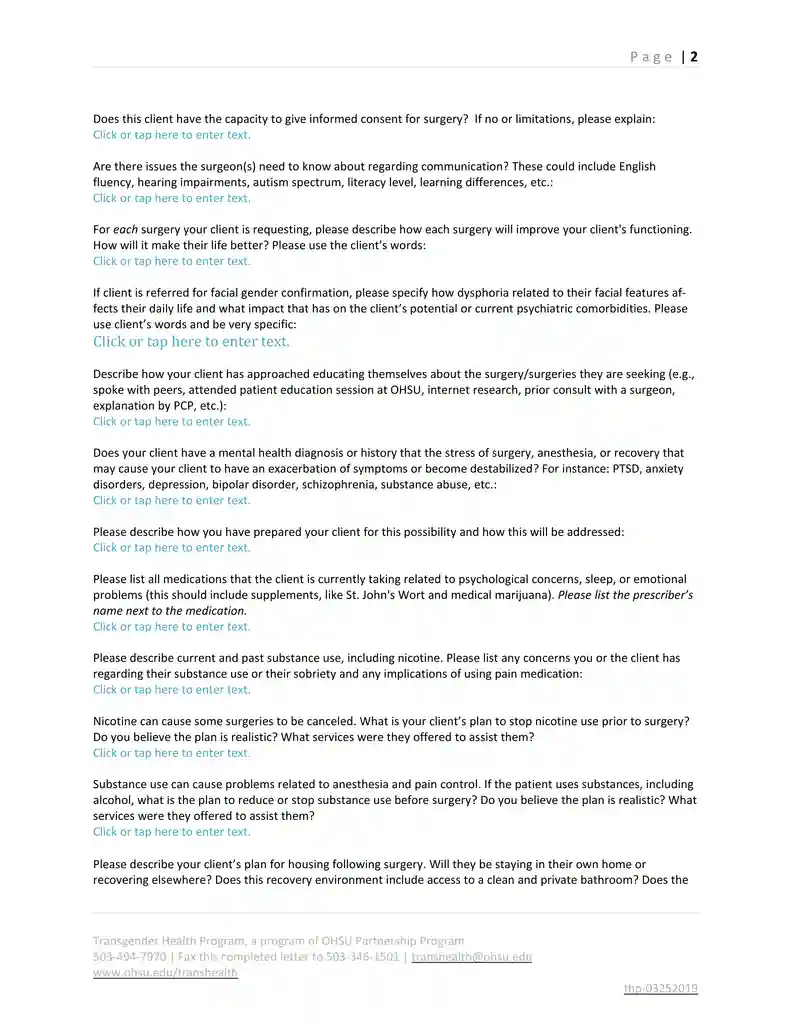
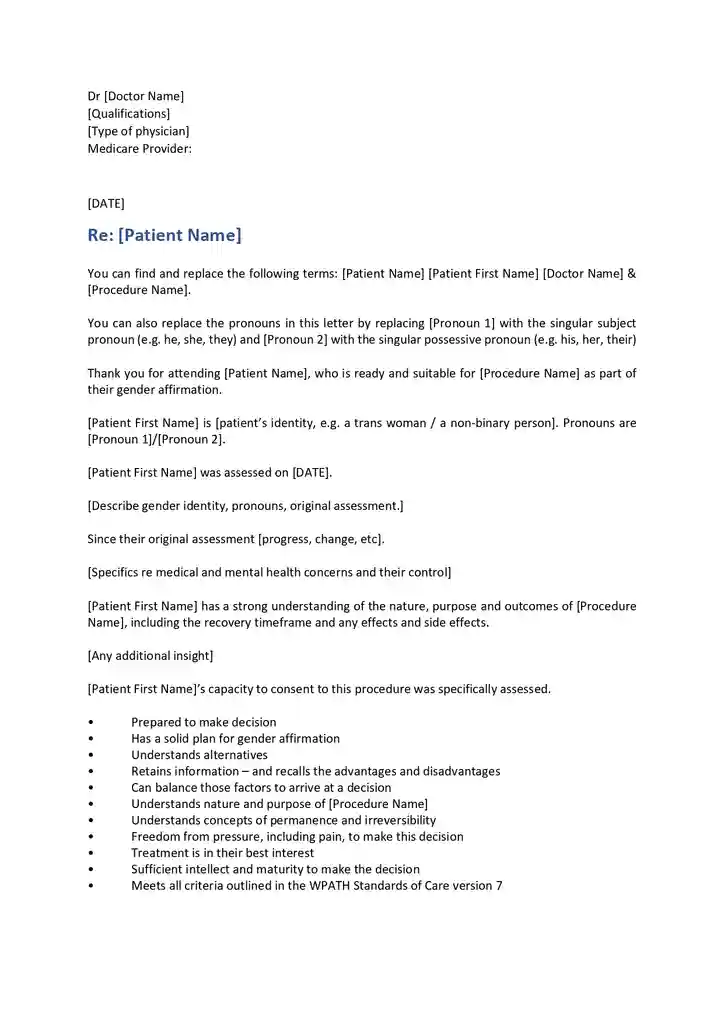
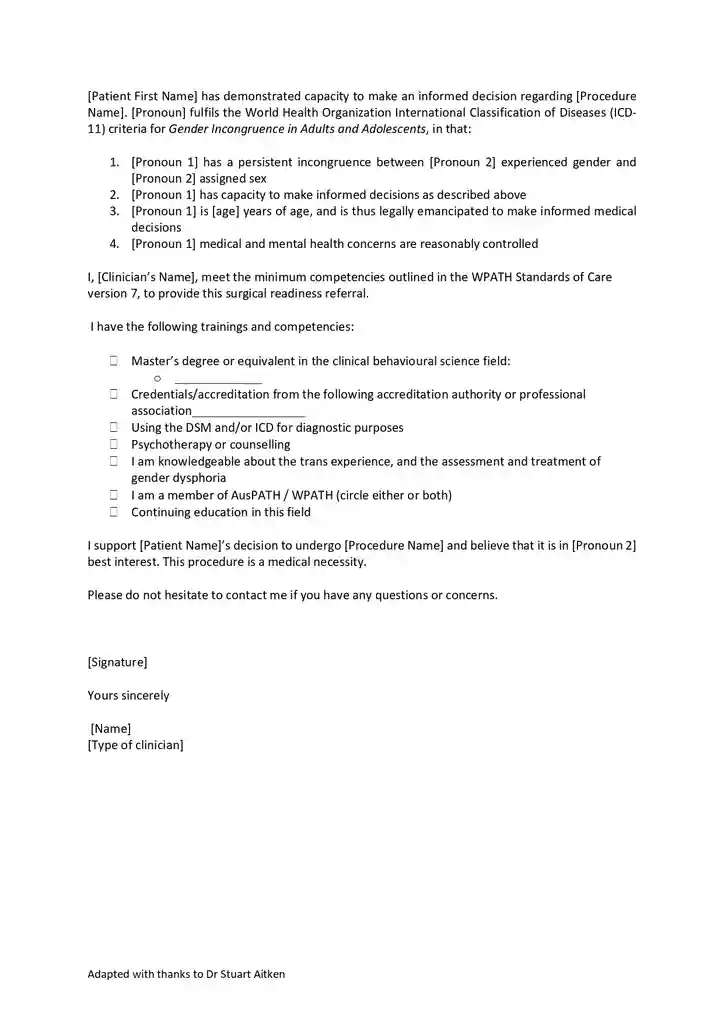
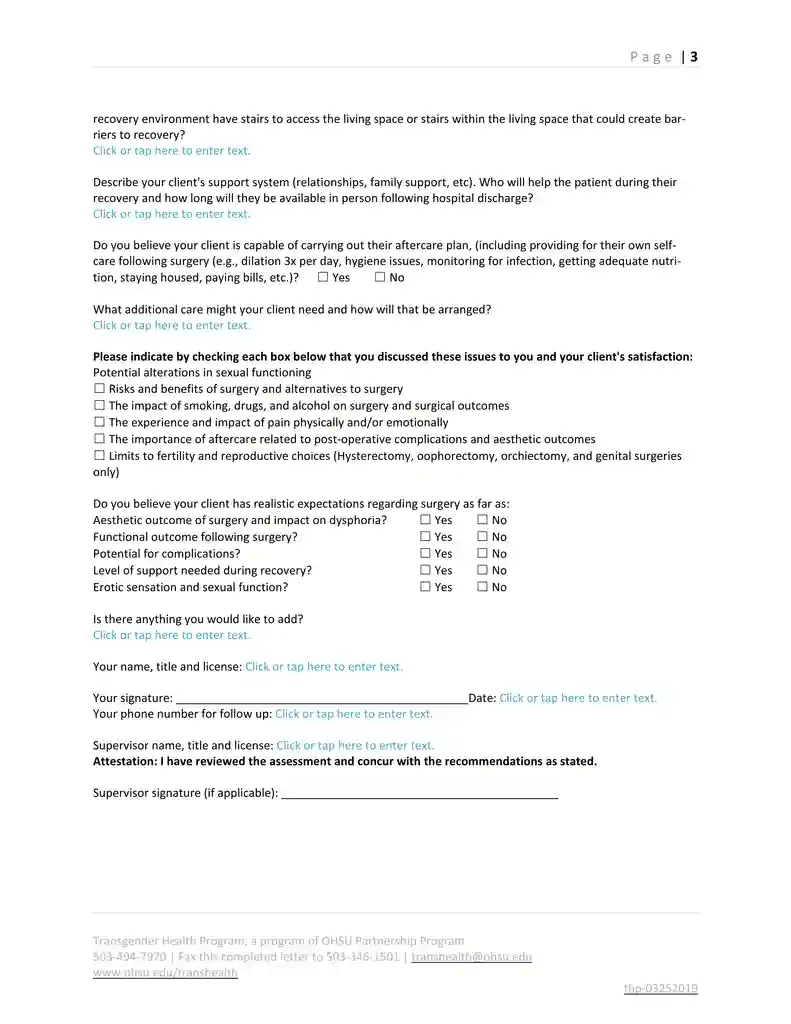
WPATH Letter Example
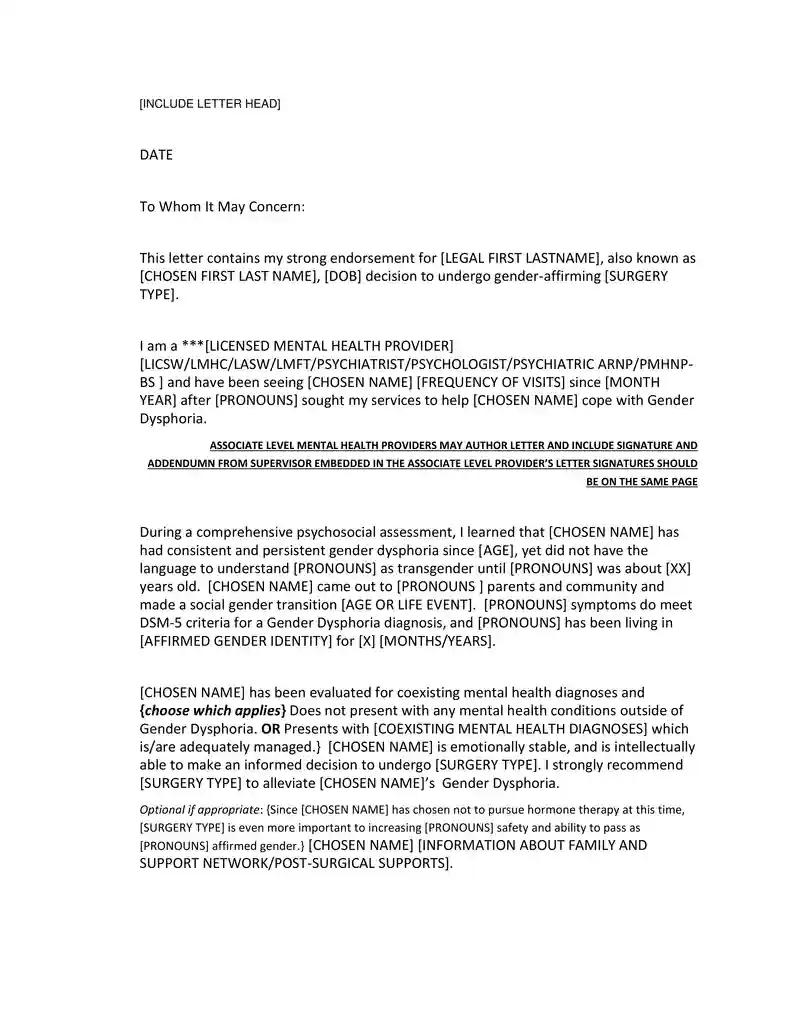
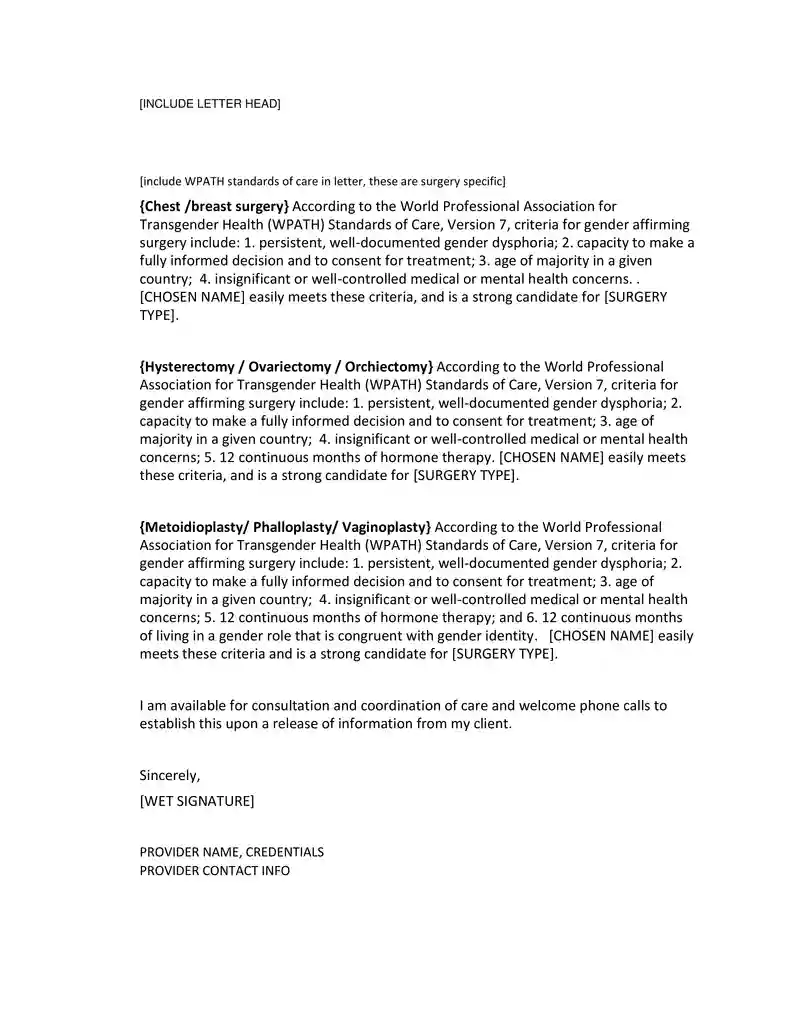

Where to Find WPATH letter
- WPATH Website: The WPATH Standards of Care (https://www.wpath.org/) have guidelines and might even have sample letters.
- Hospitals and Clinics: Places specializing in gender-affirming care often have their own templates that their surgeons prefer.
- Therapists: Therapists who work with transgender patients a lot should have good templates or be able to write a personalized letter just for you.
Important! Even if there’s a template, your letter shouldn’t feel like a form where someone just fills in the blanks. It needs to tell YOUR story and why the surgery is medically necessary for YOU.
WPATH letter requirements
To get gender-affirming surgery, you’ll usually need to meet certain medical and non-medical requirements. Here’s a breakdown:
Medical Requirements
- Diagnosis: You’ll need a formal diagnosis of gender dysphoria from a therapist, psychologist, or psychiatrist. This means a professional confirms that how you feel on the inside doesn’t match your assigned sex at birth.
- Mental Health Check-In: Your therapist will make sure you’re emotionally ready for surgery. They might talk about how you’ll cope, the pros and cons of the surgery, and whether it’s the right decision for you.
- Therapy: There’s no exact rule on how long, but WPATH (the organization that sets guidelines for transgender care) often suggests a period of living as your true gender identity. This helps make sure surgery is the next step.
- Health History: Your doctor will check if any health problems could make surgery risky.
Non-Medical Requirements
- Informed Consent: You’ll sign a form saying you understand what the surgery involves, the good, the bad, and what it can and can’t change.
- Age: The minimum age depends on the specific surgery and where you live. Top surgery might be an option for younger adults (sometimes 16+), while bottom surgery often has a stricter age limit (18+).
- Insurance: It’s not always required, but having insurance coverage that covers this kind of surgery can save you a LOT of money. Check with your insurance company for details.
Other Things to Know
- Letters of Support: Especially for bottom surgery, you might need a letter (or two) from mental health professionals who support your decision.
- Support Groups or System: It helps to have people to take care of you after surgery. Some surgeons might want to make sure you’ve got that support.
IMPORTANT! These are just general guidelines. Rules can change based on your location, your surgeon, and your insurance. The best way to know for sure is to talk to a doctor who specializes in transgender healthcare.
The Process of Getting a WPATH Letter
Getting a WPATH letter is how you work with a therapist to show you’re ready for gender-affirming surgery. Here’s a breakdown of how it works:
Step 1: Find the Right Therapist
- Specialists Only: Look for a therapist, psychologist, or psychiatrist who focuses on gender dysphoria and transgender health. They’ll know the WPATH rules (these are guidelines for transgender healthcare).
- Ask for Help: Get recommendations from your doctor, a local LGBTQ+ community+ center, or search websites like Psychology Today (https://www.psychologytoday.com/).
Step 2: Build a Connection
- It’s About Trust: The most important thing is finding a therapist you feel safe and comfortable with. This helps you open up and be honest.
- Talking it Out: You’ll talk about your gender identity, your life experiences, and how you feel about surgery.
Step 3: Take Your Time
- No Rushing: Getting a WPATH letter usually takes more than one meeting with your therapist. They need to be sure you’re ready for this big step.
- Ask Questions: This is YOUR chance to understand everything about the surgery types and to work through any worries you have.
Step 4: The Check-Up
- Mental Health Matters: Your therapist will make sure you’re emotionally ready for surgery. This is about making the right decision for YOU.
- Understanding: They’ll check that you get the good and bad parts of the surgery, and that your expectations are realistic.
Step 5: Informed Consent
- All the Info: Your therapist will explain everything the surgery involves. This includes possible risks and how it might change your body and feelings.
- Your Choice: It’s super important that you understand everything and that YOU want this surgery.
FAQ
Can I use the same template for any kind of gender-affirming surgery?
Not exactly, but they’re all similar. Your therapist will change the letter to fit the specific surgery you want. The focus will be on how that surgery helps solve your gender dysphoria and makes you feel better.
Does my therapist HAVE to use a template?
No, they could write a letter from scratch. But templates are a good idea! They act like a checklist to make sure your therapist includes everything important and uses the right kind of medical language.
Are top surgery and bottom surgery letters different?
They have the same basic parts, but the focus can change a bit. For example, a top surgery letter might talk a lot about chest dysphoria and how it affects your life. A bottom surgery letter might focus more on how your current body causes problems and how surgery would help.
Does it take a super long time to get a WPATH letter?
It Depends: There’s no set rule about how many therapy sessions you need. The important thing is that your therapist feels you’re ready for surgery.
Focus on YOU: It’s not just about the time, but about understanding the surgery and feeling emotionally prepared. That’s what the therapist is checking for!
Ugh, my insurance won’t cover the surgery! What now?
Don’t Give Up: There might be ways to get help paying for it. Look for organizations that offer financial aid or can help you fight the insurance company’s decision.
Know Your Rights: There are laws to protect transgender people. Understanding these laws can help you get the surgery you need.
Wait, I need TWO letters for bottom surgery? Why?
Extra Careful: Bottom surgery is a big decision. WPATH suggests two letters to make extra sure it’s the right choice for you.
It’s for Your Benefit: Think of it as extra support to help you get the best possible results from your surgery!
Can I get a WPATH letter if I’m a teenager?
It’s Complicated: Some therapists do work with teens, but it can be harder to find them. There are special resources out there to help you and your family.
Conclusion
Getting a WPATH letter is a significant milestone on your gender affirmation journey. It demonstrates your commitment to your well-being and can open doors to the care you deserve. If you need support, remember you’re not alone! Seek out resources and connect with the transgender community for guidance and encouragement.

The content creator team at calipsotree.com is dedicated to making topics accessible to everyone, with over 9 years of experience in writing and breaking down complex concepts into easy-to-understand articles that answer readers’ financial questions.








